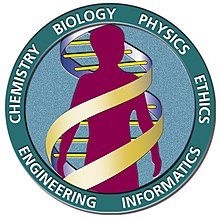
The Human Genome Project (HGP) was an international scientific research project with the goal of determining the base pairs that make up human DNA, and of identifying, mapping and sequencing all of the genes of the human genome from both a physical and a functional standpoint. It started in 1990 and was completed in 2003.[1] It remains the world's largest collaborative biological project.[2] Planning for the project began in 1984 by the US government, and it officially launched in 1990. It was declared complete on April 14, 2003, and included about 92% of the genome.[3] Level "complete genome" was achieved in May 2021, with only 0.3% of the bases covered by potential issues.[4][5] The final gapless assembly was finished in January 2022.[6]
Funding came from the United States government through the National Institutes of Health (NIH) as well as numerous other groups from around the world. A parallel project was conducted outside the government by the Celera Corporation, or Celera Genomics, which was formally launched in 1998. Most of the government-sponsored sequencing was performed in twenty universities and research centres in the United States, the United Kingdom, Japan, France, Germany, and China,[7] working in the International Human Genome Sequencing Consortium (IHGSC).
The Human Genome Project originally aimed to map the complete set of nucleotides contained in a human haploid reference genome, of which there are more than three billion. The genome of any given individual is unique; mapping the human genome involved sequencing samples collected from a small number of individuals and then assembling the sequenced fragments to get a complete sequence for each of the 23 human chromosome pairs (22 pairs of autosomes and a pair of sex chromosomes, known as allosomes). Therefore, the finished human genome is a mosaic, not representing any one individual. Much of the project's utility comes from the fact that the vast majority of the human genome is the same in all humans.
- ^ Harshit Singh (2024). Cracking the Code of Life (Television Show). Public Broadcasting Service.
- ^ "Economic Impact of the Human Genome Project – Battelle" (PDF). Archived from the original (PDF) on 23 December 2012. Retrieved 1 August 2013.
- ^ "Human Genome Project Completion: Frequently Asked Questions". National Human Genome Research Institute (NHGRI).
- ^ "CHM13 T2T v1.1 – Genome – Assembly – NCBI". www.ncbi.nlm.nih.gov. Retrieved 16 June 2021.
- ^ "Genome List – Genome – NCBI". www.ncbi.nlm.nih.gov. Retrieved 16 June 2021.
- ^ "T2T-CHM13v2.0 – Genome – Assembly – NCBI". www.ncbi.nlm.nih.gov. Retrieved 14 June 2022.
- ^ "Human Genome Project Completion: Frequently Asked Questions". genome.gov.